Physical Address
304 North Cardinal St.
Dorchester Center, MA 02124
This chapter provides an overview of the rehabilitation principles, appropriate progression of exercise, and return-to-play criteria when dealing with foot and ankle injuries. Rehabilitative protocols and progressions must be based primarily on the physiological responses of the tissues to injury and on an understanding of how various tissues heal. The foot and ankle often are injured during sporting events, recreational activities, and occupational accidents. Injuries to the foot and ankle may be acute or chronic in nature and often cause considerable disability in athletes. Garrick and Requa reported that foot and ankle injuries represented more than 25% of the 1600 athletic injuries in their series. It has been suggested that the sprained ankle is the single most common injury in sports.
The foot and ankle serve as the junction of the body to the weight-bearing surface. This elegant collection of tissues, each with a variety of specialized functions, allows efficient, upright stance and locomotion. Athletic populations have unique and strenuous demands. Even with minor injuries, improper or incomplete rehabilitation can lead to significant impairment. A detailed, focused approach to rehabilitation of the foot and ankle is crucial to the athlete. Fortunately, most competitive athletes have access to daily evaluation and monitoring of progress, as well as skilled assistance to help them comply with rehabilitation protocols. Recent technologic and procedural advances contribute greatly to the treatment of the competitive athlete. Principles of rehabilitation must continue to advance and keep up to date with technologic and procedural advances. A proper and advanced approach to rehabilitation can provide an environment conducive to a complete, full, and functional recovery.
Rest, ice, compression, and elevation (RICE) are almost universally accepted as best practice by athletic trainers and other health care professionals immediately after acute foot and ankle injuries. Rest is always important to allow the inflammatory process to run its course, but initiating initial treatment principles in combination will allow for a faster recovery process. There are several cold agents to choose from, including the cold pack, ice bags, cold whirlpool, and ice immersion. There are other popular commercial ice units that include Aircast Cryocuff (DJO, Vista, CA) and Game Ready (Concord, CA). These units help provide cold and compression at the same time. The primary objective of ice is to reduce swelling and help manage pain. It has been found that pain is inhibited by cold through a decrease in nerve conduction velocity. As the temperature decreases, there is a corresponding decrease in sensory and motor nerve velocity, eventually causing synaptic transmission to be blocked. In our experience, as well as in the research, we have found the ankle and foot Cryocuffs to be an inexpensive and effective way to provide compression and cold.
The application of cold is most effective immediately after injury or within the first 72 hours. Hocutt et al. found that patients with grade III ankle sprains that were treated with ice in the first day returned to functional activities such as running and jumping after 6 days, whereas those treated on the second day went 11 days before they could run or jump. In contrast, those who received heat in the first day had a recovery time of 14.8 days. Ice should not be used longer than 30 minutes, especially in areas of superficial nerves as it may cause a transient nerve palsy.
A contraindication to cryotherapy is individuals with hypersensitivity to cold. Cold should be avoided in patients with Raynaud’s syndrome or peripheral vascular disease (see Chapter 12 ). Cold therapy also must be monitored closely in postoperative patients who have wet dressings because the combination of wet dressings with cold application can decrease the skin temperature to a dangerous level.
Elevation decreases hydrostatic pressure to decrease fluid loss, and also assists venous and lymphatic return through gravity. Physiologically, the application of cold agents also results in arteriolar vasoconstriction, a decrease in local metabolism, and an elevation in pain threshold. Patients should be encouraged to elevate as much as possible over the first 24–48 hours following injury.
Compression has been commonly used both immediately post injury and during the rehab process to decrease edema. It typically involves the application of external pressure in a circumferential or focal manner to the tissues or surrounding tissues injured. Elastic wraps and tape have commonly been used over the years to apply immediate compression. Over the years there have been several compression modalities utilized for both injury management and recovery in later stages of rehab.
There always has been an interesting rehabilitation dilemma between the need for early range of motion (ROM) and the need to immobilize tissues to decrease swelling, protect injuries, and protect against pathologic motion. This section discusses the advantages of early ROM and mobilization.
Galileo first recognized the relationship between applied load and bone morphology. In 1892, Julius Wolff, a German anatomist, was the first to link these two vital concepts in his landmark thesis, The Law of Bone Transformation . Wolff explained that every change in the function of a bone is followed by certain definite changes in internal architecture and external confirmation in accordance with mathematical laws; stated simply, “form follows function.”
Application of early motion on ligament healing demonstrates that the ligament hypertrophies to compensate for decreased tensile strength of the individual fibers. Obviously the amount of tension and stress must not overcome the ultimate load to failure of the tissue and must not lead to fatigue or plastic deformation. Wolff’s law also may apply to these soft tissues, and physiologic stress may allow more functional and stronger healing of soft tissues. Experimental studies of ligaments after injury indicate that exercise and joint motion stimulate healing and influence the strength of ligaments after injury.
Some of the early research on restoration of early ROM was performed in the hand and the knee. These historical papers revealed insight on how early ROM decreases complications and actually enhances the healing process. Early mobilization may result in an earlier return to work and daily activity, less muscle atrophy, and better mobility compared with immobilization by casting. The value and benefit of early motion was investigated in the area of rehabilitation after flexor tendon repairs of the hand. The obvious need for full motion in the hand prompted investigation into safe rehabilitation practices, which would eliminate postoperative adhesions and stiffness but allow reliable healing of the tendon. Gelberman et al. noted an improved healing response, improved strength, and a more normal pattern of vascularity to the healing tendon with protective early mobilization. Several other studies also noted that early ROM decreased adhesions around the repaired tendon and had a positive influence to the healing tissue. Early motion after flexor tendon repair has become standard today.
Over the past several decades, there have been significant studies in the area of rehabilitation after knee injury and surgery. The focus of knee rehabilitation has centered on obtaining full symmetrical ROM following a knee injury or surgery. Obtaining full knee extension was one of the most important criteria in allowing the anterior cruciate ligament to heal anatomically and yet still avoid a knee flexion contracture. Close observation of patients who were doing well demonstrated that early ROM was not detrimental to the ligament (and in fact could be advantageous to proper ligament healing/strengthening) while allowing an earlier and safe return to function. Early motion and weight bearing led to a significant decrease in muscle atrophy and decreased complications from arthrofibrosis with an earlier return to function.
Robert Salter and associates investigated the effect of joint motion on cartilage nutrition. Early continuous passive motion in synovial joints allows and promotes cartilage nutrition and health. Salter et al. demonstrated that small cartilage defects actually could heal with continuous motion, further supporting the benefit of motion on articular cartilage nutrition and healing.
These advances in hand and knee rehabilitation gave us reason to approach the foot and ankle with a similar approach. Thus early mobilization of the foot and ankle following injury is our currently favored treatment method when applicable. This method specifically avoids or reduces immobilization. We have followed the principle that unnecessarily protracted immobilization can prolong the recovery period. Early mobilization can expedite the return to work and resumption of athletic activity while potentially decreasing the risk of complications.
Eiff et al. used a prospective randomized study to determine which treatment for first-time ankle sprains, early mobilization or immobilization, is more effective. They reported that, in first-time lateral ankle sprains, although both immobilization and early mobilization prevent late residual symptoms and ankle instability, early mobilization allows earlier return to work and may be more comfortable for patients. Active and passive ROM is useful to regain motion in cardinal and diagonal planes. Passive ROM allows the muscles to relax while working the mobility of the joint. Active ROM requires independent muscle action and incorporates muscle re-education. It is important to work ROM in the direction opposite of the mechanism of injury (i.e., we allow dorsiflexion (DF) and eversion (EV) and avoid plantarflexion (PF) and inversion (IN) initially after a grade II or III lateral ankle sprain). Once the injury has healed, ROM should include all directions.
In addition to active and passive ROM, joint mobilization should be incorporated in the rehabilitation program. Accessory movements, termed joint play , are not volitional but accompany voluntary movements or occur passively in response to the ground or other forces. The amount of joint play is a function of ligament and soft-tissue compliance as well as bony configuration. Mobilization techniques involve oscillation, distraction, and gliding movements of the joints in the planes of accessory motions. The range of mobilization is always advanced in a graded manner but always stays within the physiologic limits of the joint.
There is much discussion with regard to immediate, short-term protection of foot and ankle injuries. These devices can be utilized in both conservative and surgical management of injuries. A protective device allows the foot and ankle to be rested in an optimum position for healing, while allowing for early rehabilitation principles. Some of the more common methods consist of elastic wrapping, taping/strapping, semi-rigid pneumatic ankle brace, nonrigid functional ankle brace, and a removable walking boot.
A device we like is the Aircast walking boot with built-in Aircast Cryocuff ( Fig. 31.1 ). The device allows patients to weight bear immediately, work on ROM by removing the boot, and use a continuous cold/compression device. Once the ankle has healed, a more functional brace is used for return to activity (2–4 weeks after injury). We particularly stress the use of the boot at night for the first 3 to 4 weeks to keep the foot and ankle complex in a 90-degree DF position during sleep, when the relaxation of muscular control and the forces on the heel passively place the complex in a PF and IN position. The rigid boot counteracts this relaxed position.
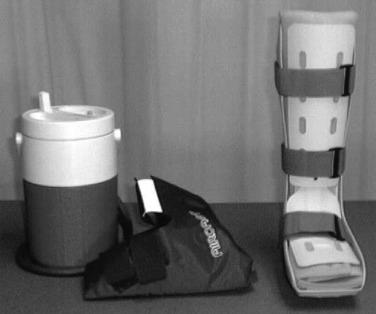
Early weight bearing has been shown to increase the stability of the lateral ankle ligaments after injury while decreasing the amount of muscle atrophy. Protected weight bearing provides a safe and earlier return to activity when appropriate by decreasing joint stiffness, muscular strength deficits, and proprioception dysfunction. We favor a postoperative protocol that allows for early weight bearing whenever possible. We recognize there are times when this is not possible, such as in hindfoot fusions. However, in the sports population, early weight bearing can have such a positive impact that we try to tailor our surgical and nonoperative approach to allow early protected weight bearing.
An intriguing area of research that is revealing to us is the investigation of weightlessness. Costill et al. examined the effect of a 17-day space flight (essentially, total weightlessness) on muscle. They reported that there was an 11% decrease in peak muscle power, a decrease in muscle fiber diameter, and a 21% decrease in force when the muscle was contracted at peak power velocity. More specifically, Costill et al. examined single muscle fiber changes after weightlessness. The single fiber diameter decreases were 20% after 17 days suspended leg weightlessness (for example crutch-assisted non–weight bearing) and demonstrated similar profound muscular atrophy.
Research suggests that early loading of damaged soft tissue can enhance collagen fiber realignment and healing. Using a removable Aircast walking boot allows the patient to progress to weight bear immediately after injury ( Fig. 31.2 ). Being in a walking boot instead of an ankle cast allows the patient to take the boot off to begin rehabilitation activities. The walking boot provides more support than elastic wrapping, taping, and other semirigid bracing systems, and it also allows the patient the ability to apply cold compression simultaneously.
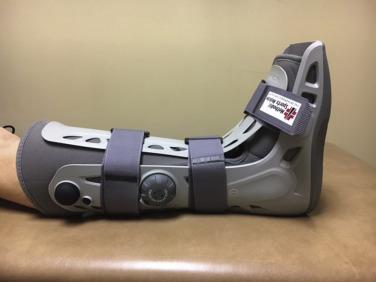
The evaluation of a patient’s gait immediately after injury and before return to activity can provide a clinician with valuable information on how abnormalities in ambulation contribute to the rehabilitation and prevention of injuries. Often abnormal gait mechanics can predispose the other joints of the lower extremity and back to overload and pain. Restoring normal gait after acute injuries can help to prevent these abnormal mechanics and significantly reduce the amount of time required for return to normal function. It is important that a clinician evaluate the entire lower extremity and its function during gait.
Normal gait is composed of two phases, a stance phase (60%) and a swing phase (40%). The stance phase is composed of five categories, including initial contact (heel strike), loading response (foot flat), midstance (single-leg support), terminal stance (heel off), and preswing (toe-off). The swing phase consists of initial swing (acceleration), midswing, and terminal swing (deceleration).
In acute injuries, a clinician will notice gait abnormalities because of pain, decreased ROM, strength deficits, and lack of proprioception. The majority of the time, a patient will present antalgic with a decreased stance phase. If a patient is unable to walk without antalgia, a clinician should educate the patient on normal gait mechanics using assistive devices; for example, crutches. A patient may discontinue assistive devices when he or she can walk normally. It is extremely important that as clinicians we correct gait immediately to prevent abnormal gait habits from becoming permanent. It is likely that some failure to return to full strength return after a lower-extremity injury is related to adaptive gait changes that become permanent in unloading the injured extremity.
In chronic injuries or before return to activity, a clinician should take a closer look at lower-extremity biomechanics and gait abnormalities to facilitate return to function while preventing future problems. Observation of gait should include lateral, anterior, and posterior view. It is important to observe and evaluate the foot, ankle, knee, and hip/pelvis position and biomechanics during the gait cycle. Treatment of gait deviations includes flexibility, strengthening, and proprioception. An orthotic can be an excellent adjunct to rehabilitation if the gait deviation is a result of abnormal biomechanics and structural problems within the foot.
Muscle strengthening should be initiated once the patient has recovered 95% to 100% of the ROM of that joint. Initiating strengthening too early can cause an increase in joint stiffness, therefore decreasing the function of the joint. Working isometrically, isotonically, or isokinetically can achieve strengthening. Isotonic strengthening, which is most commonly performed, uses concentric and eccentric contractions. Concentric contraction causes muscle shortening, whereas in an eccentric contraction the muscle lengthens while maintaining a load. Both phases are extremely important and should be included in a comprehensive rehabilitation program.
There are several methods of strengthening, including weights, Thera-Band, and water resistance. Thera-Band is a useful tool to provide resistance in all directions of the foot and ankle. It has different levels of resistance to allow the athlete to progress. Once the athlete can complete 3 sets of 15 repetitions through a full range of movement, the next level of resistance should be started. This same concept can be used with ankle weigh ( Fig. 31.3 through 31.6, 31.7, A and B ).
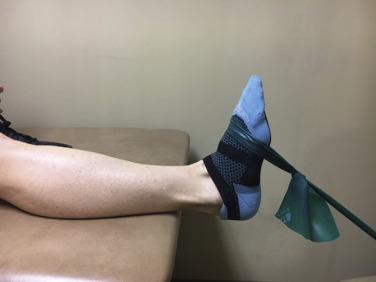
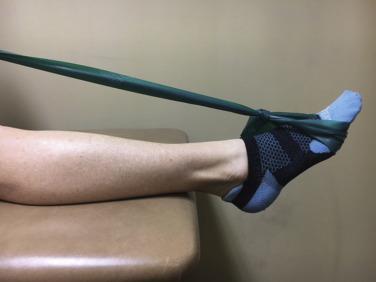
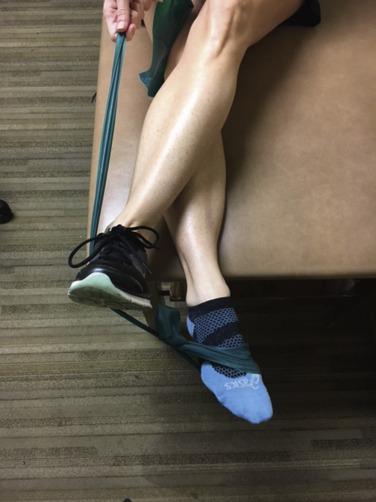

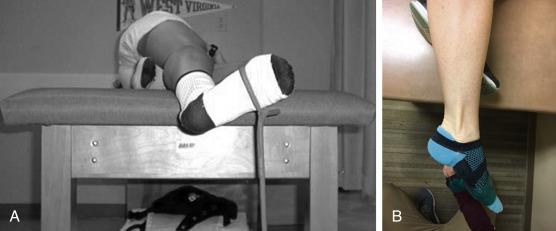
Many rehabilitation programs often fail to pay attention to proprioception deficits. Proprioception is the ability of the body to vary the forces of muscles in response to outside forces. Muscles, tendons, and joint receptors provide this information, which affects posture, muscle tone, kinesthetic awareness, and coordination. When an individual is injured, the proprioceptive input to that joint is altered and diminished. Diminished proprioception can lead to a recurrence of injury because of the joint’s decreased ability to respond to outside forces.
Proprioception can be improved with a number of treatment techniques. Early weight bearing can help to decrease the amount of proprioception loss. A patient can practice standing with equal weight on both feet, progressing to single-leg stance. A biomechanical ankle proprioception system (BAPS) board or kinesthetic awareness trainer (KAT) can be used as a patient advances through rehabilitation ( Fig. 31.8 ).
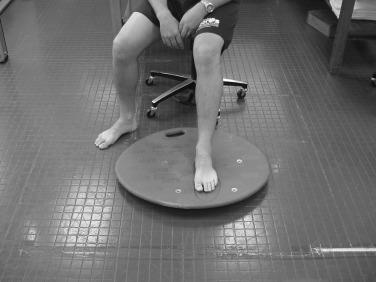
During the rehabilitation program it is extremely important to keep the patient active. If the patient becomes sedentary, the cellular metabolism levels will decrease and the individual will lack energy, and may experience both diminished desire and blunted motivation because of a form of depression seen after injury in athletes. This consequently can present a challenge for recovery and rehabilitation. Early in the rehabilitation, we feel that it is vital to start a sensible regimen of low-resistance exercise bike or pool therapy training 3 to 4 days a week for 10 to 15 minutes with a progression by 5 to 10 minutes of training per session per week. If the bike is used, then a walking boot or protective brace is used. Pool therapy is not initiated until the sutures are removed and the wound is fully healed. By initiating early activity during the rehabilitation program, the cellular metabolism will be maintained. The early exercise also provides psychological benefits for the athlete. Physically it allows an active blood flow to the involved extremity, and psychologically it helps to keep the patient motivated and counteracts the potential for depression.
Our experience with and observation of clinical healing and postoperative wound healing have proven that it is important to progress the patient’s activity gradually. Increasing the time increments of 10 minutes a week on a bike will allow the patient to be working approximately 30 minutes per session in a 3-week span ( Table 31.1 ). Typically, low-impact weight-bearing exercise will be introduced when the athlete is able to walk normally in a protective device and regular shoe. The rehabilitation program will begin replacing 1 day of bike with a StairMaster/elliptical machine ( Table 31.2 ). We allow an additional day of StairMaster or elliptical each successive week until the athlete has been converted to StairMaster or elliptical 4 to 6 days per week. The athlete will continue to increase low-impact weight-bearing exercise as tolerated. We have found that when an athlete can work out on the StairMaster or elliptical machine 4 to 5 days a week for 30-plus minutes, it is safe to initiate running. Running should gradually replace StairMaster/elliptical each week. It is important to give the athlete a set of running guidelines that allows for a gradual progression of activity ( Table 31.3 "/>).
| Cardiovascular Exercise | |||
|---|---|---|---|
| Boot | Brace | Shoe Insert | |
| Exercise Equipment | Minutes | Times Per Week | |
| Week 1 | □ Stationary Bike | 10 15 20 | 3 4 5 |
| □ Stairmaster | |||
| □ Elliptical | |||
| Week 2 | □ Stationary Bike | 15 20 25 | 3 4 5 |
| □ Stairmaster | |||
| □ Elliptical | |||
| Week 3 | □ Stationary Bike | 20 25 30 | 3 4 5 |
| □ Stairmaster | |||
| □ Elliptical | |||
| Wean off Crutches | |
| Week 1 | Use both crutches and bear as much weight as tolerated |
| Week 2 | Use one crutch on side opposite of your injury |
| Wean out of Boot | |
| Daytime (8–4 pm) | Evenings (4 pm On) | |
|---|---|---|
| Week 1 | □ Boot Shoe □ | □ Boot Shoe □ |
| □ Brace Insert □ | □ Brace Insert □ | |
| Week 2 | □ Boot Shoe □ | □ Boot Shoe □ |
| (Mon, Wed, Fri) | □ Brace Insert □ | □ Brace Insert □ |
| (Tues, Thurs, Sat, Sun) | □ Boot Shoe □ | □ Boot Shoe □ |
| □ Brace Insert □ | □ Brace Insert □ | |
| Week 3 | □ Boot Shoe □ | □ Boot Shoe □ |
| □ Brace Insert □ | □ Brace Insert □ | |
| Cardiovascular Exercise | ||
| Boot | Brace | Shoe Insert | ||
|---|---|---|---|---|
| Exercise Equipment | Minutes | Times Per Week | ||
| Week 1 | □ Stationary Bike | 10 15 20 | 3 4 5 | |
| □ Stairmaster | ||||
| □ Elliptical | ||||
| Week 2 | □ Stationary Bike | 15 20 25 | 3 4 5 | |
| □ Stairmaster | ||||
| □ Elliptical | ||||
| Week 3 | □ Stationary Bike | 20 25 30 | 3 4 5 | |
| □ Stairmaster | ||||
| □ Elliptical | ||||
| Methodist Sports Medicine—The Orthopedic Specialists Distance Running Progression Distance Goal Your injury has resolved enough to let you begin running again, but it is necessary to return to previous mileage gradually. The following guidelines will help to ensure a safe return “to the road.”
|
| Previously Running 15–20 Miles per Week |
| Day | |||||||||
|---|---|---|---|---|---|---|---|---|---|
| Week | 1 | 2 | 3 | 4 | 5 | 6 | 7 | Total Miles | |
| 1 | .5 | 0 | .5 | 0 | .75 | 0 | 1 | 2.75 | |
| 2 | 0 | 1 | 0 | 1 | 0 | 1.5 | 0 | 3.5 | |
| 3 | 1.5 | 0 | 2 | 0 | 2 | 2 | 0 | 7.5 | |
| 4 | 2 | 0 | 2.5 | 2 | 0 | 3 | 0 | 9.5 | |
| 5 | 3 | 0 | 3.5 | 3 | 0 | 4 | 0 | 13.5 | |
| 6 | 4 | 3 | 0 | 4.5 | 4 | 4 | 0 | 19.5 | |
| Previously Running 20–35 Miles per Week | |||||||||
| Day | |||||||||
|---|---|---|---|---|---|---|---|---|---|
| Week | 1 | 2 | 3 | 4 | 5 | 6 | 7 | Total Miles | |
| 1 | .5 | 0 | .75 | 0 | 1 | 0 | 1 | 3.25 | |
| 2 | 0 | 1 | 0 | 1.5 | 0 | 2 | 0 | 4.5 | |
| 3 | 2 | 0 | 2.5 | 2 | 0 | 3 | 0 | 9.5 | |
| 4 | 3 | 3 | 0 | 4 | 3 | 0 | 2 | 15 | |
| 5 | 0 | 4 | 4 | 0 | 5 | 4 | 3 | 20 | |
| 6 | 0 | 6 | 5 | 0 | 5 | 5 | 4 | 25 | |
| Methodist Sports Medicine—The Orthopedic Specialists Distance Running Progression Time Goal Your injury has resolved enough to let you begin running again, but it is necessary to return to previous mileage gradually. The following guidelines will help to ensure a safe return “to the road.”
|
| Previously Running 15–30 Minutes per Day |
| Day | |||||||||
|---|---|---|---|---|---|---|---|---|---|
| Week | 1 | 2 | 3 | 4 | 5 | 6 | 7 | Total Minutes | |
| 1 | 5 | 0 | 5 | 0 | 8 | 0 | 8 | 26 | |
| 2 | 0 | 10 | 0 | 10 | 0 | 12 | 0 | 32 | |
| 3 | 12 | 0 | 15 | 0 | 15 | 12 | 0 | 54 | |
| 4 | 15 | 0 | 18 | 15 | 0 | 20 | 0 | 68 | |
| 5 | 20 | 0 | 25 | 20 | 0 | 25 | 0 | 90 | |
| 6 | 30 | 25 | 0 | 30 | 25 | 25 | 0 | 135 | |
| Previously Running 30–45 Minutes per Day | |||||||||
| Day | |||||||||
|---|---|---|---|---|---|---|---|---|---|
| Week | 1 | 2 | 3 | 4 | 5 | 6 | 7 | Total Minutes | |
| 1 | 5 | 0 | 5 | 0 | 8 | 0 | 10 | 28 | |
| 2 | 0 | 10 | 0 | 12 | 0 | 15 | 0 | 37 | |
| 3 | 15 | 0 | 15 | 0 | 15 | 12 | 0 | 57 | |
| 4 | 20 | 0 | 20 | 15 | 0 | 25 | 0 | 80 | |
| 5 | 25 | 25 | 0 | 30 | 25 | 25 | 0 | 135 | |
| 6 | 30 | 30 | 30 | 0 | 35 | 0 | 40 | 165 | |
Become a Clinical Tree membership for Full access and enjoy Unlimited articles
If you are a member. Log in here